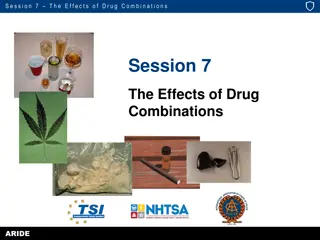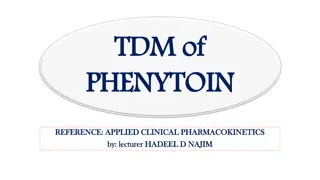Understanding Barbiturates: History, Types, and Mechanism of Action
Barbiturates are derivatives of barbituric acid, acting as depressants on the central nervous system by potentiating GABA. First synthesized in 1864, they have a rich history in medicine. Types include Amobarbital, Phenobarbital, and Pentobarbital. The synthesis of barbituric acid involves a condens
0 views • 28 slides
Understanding the Nervous System: CNS, PNS, SNS, and ANS
The nervous system comprises the Central Nervous System (CNS) and Peripheral Nervous System (PNS), with the PNS further divided into the Somatic Nervous System (SNS) and Autonomic Nervous System (ANS). The SNS controls voluntary movements of skeletal muscles, while the ANS regulates involuntary proc
2 views • 23 slides
Indirect-Acting Cholinergic Drug
Explore the classification, mechanism of action, and pharmacological effects of indirect-acting cholinergic drugs such as anticholinesterases. Learn about the importance, main uses, adverse effects, and contraindications of these drugs. Discover how anticholinesterases increase acetylcholine concent
1 views • 16 slides
Latest Research Updates on Brain and CNS Cancer Studies
SWAG Network Brain & CNS Cancer Clinical Advisory Group provides research updates on national brain cancer recruitment, national vs. regional recruitment, and ongoing brain cancer studies in the SWAG region. Additionally, insights from the Cancer Patient Experience Survey 2021 shed light on patient
0 views • 10 slides
Understanding the Pituitary Gland: Implications in Psychiatry
This presentation by Dr. Alexsandra Urhi delves into the anatomy, function, and psychiatric implications of the pituitary gland. It explores the interplay between endocrine structures, the CNS, and psychotropic drugs' effects on the pituitary gland.
0 views • 35 slides
Analyzing Interaction Effects in Composite-Based SEM
Explore the concept of interaction effects in composite-based structural equation modeling (SEM) through topics like the logic of interaction, estimating effects, multigroup analysis, and visualizing effects. Learn about moderators, their role in relationships between variables, and techniques for a
1 views • 23 slides
Intravenous Anaesthetics and Barbiturates: Usage, Advantages, and Disadvantages
Intravenous anaesthetics, including barbiturates and non-barbiturates, offer advantages such as easy induction and smooth recovery but come with drawbacks like lack of control over anaesthesia level and contraindications in certain conditions. Barbiturates, derived from melonyl urea, are classified
1 views • 24 slides
Understanding the Effects of Drug Combinations in ARIDE Session 7
Dive into Session 7 of the ARIDE program to explore the prevalence of drug and alcohol use, the concept of polydrug impairment, and the potential effects of combining different substances. Learn about null effects, overlapping effects, and how various drug combinations can impact impairment indicato
0 views • 18 slides
Understanding Factorial Designs in Experiments
Factorial designs in experiments allow researchers to study the effects of multiple independent variables simultaneously. This type of design enables the examination of main effects and interactions between factors, providing a comprehensive understanding of the research variables. Main effects refe
1 views • 25 slides
CNS Inspectors Training and Responsibilities in Civil Aviation Safety Oversight
In this chapter, the focus is on the training, qualifications, duties, and responsibilities of CNS inspectors in civil aviation safety oversight. It covers the importance of education and training, ICAO guidance on training, and the role of Civil Aviation Safety Inspectors (CASI) as qualified indivi
0 views • 47 slides
Understanding Phenytoin Therapy - Clinical Pharmacokinetics and Serum Concentrations
Phenytoin, a medication with high protein binding and hepatic metabolism, exhibits saturated pharmacokinetics with a narrow therapeutic range of 10-20 µg/mL for total serum concentrations. Adverse effects vary with serum levels: minor CNS depression at >15 µg/mL, nystagmus at >20 µg/mL, and ataxi
0 views • 55 slides
Overview of Central Nervous System Stimulants in Pharmaceutical Chemistry
Central Nervous System Stimulants encompass a diverse group of agents with various effects on the CNS, including analeptics, methylxanthines, central sympathomimetic drugs, and antidepressants. Analeptics are potent CNS stimulants with limited use, while methylxanthines like caffeine have widespread
4 views • 41 slides
Understanding Purine Alkaloids and Their Pharmacological Activities
Purine alkaloids are a class of compounds with a unique structure, different from typical alkaloids. They include caffeine, theophylline, and theobromine, each with distinct effects on the body. These compounds are found in plants like coffee, tea, and cola, and have various pharmacological activiti
4 views • 15 slides
Classification of Drugs Acting on Central Nervous System
The Central Nervous System (CNS) plays a crucial role in coordinating the body's functions and responses to the environment. Drugs acting on the CNS can be classified into CNS stimulants and CNS depressants. CNS stimulants include spinal, medullary, and cortical stimulants, with various direct and i
0 views • 10 slides
Complications and Presentations of Tuberculosis: A Detailed Overview by Dr. Ruchi Dua
This presentation by Dr. Ruchi Dua, Associate Professor at Aiims Rishikesh, delves into the complications of tuberculosis including local and systemic effects, as well as various presentations of extrapulmonary TB. Topics covered include common complications like respiratory failure, pleural effusio
0 views • 36 slides
Overview of Non-Steroidal Anti-Inflammatory Drugs (NSAIDs) in Veterinary Pharmacology
Non-steroidal anti-inflammatory drugs (NSAIDs) are a diverse group of medications with analgesic, anti-inflammatory, and antipyretic effects. They act primarily on peripheral pain mechanisms and have limited CNS effects. NSAIDs have a long history dating back to the use of White Willow bark, and the
0 views • 16 slides
Understanding CNS Stimulants: An Overview
Central Nervous System (CNS) stimulants are drugs that stimulate and improve brain functions. They counteract CNS depression caused by various factors but can have adverse effects if overdosed. Categories include psychostimulants, brain stem stimulants, convulsants, and psychotomimetics. Examples su
4 views • 11 slides
Global Air Navigation Plan Framework Overview
The International Civil Aviation Organization (ICAO) is developing a revised Global Air Navigation Plan (GANP) to enhance global planning mechanisms. The plan includes strategic documents for regional and national air navigation infrastructure planning, with a focus on CNS/ATM systems and discipline
1 views • 19 slides
Understanding the Nervous System and Sensory Neurons
The nervous system plays a crucial role in connecting the central nervous system (CNS) to limbs and organs through the peripheral nervous system (PNS). It consists of sensory neurons that transmit impulses from sensory receptors to the CNS, allowing us to perceive and respond to various stimuli. The
0 views • 23 slides
Understanding Interaction Effects in Regression Analysis using SAS 9.4
Regression models help analyze effects of independent variables (IVs) on dependent variables (DVs, like weight loss from exercise time). Interactions explore how one IV's effect can be modified by another IV (moderating variable, MV). In this seminar's purpose, techniques to estimate, test, and grap
0 views • 137 slides
Comprehensive CNS Examination Guidelines by Dr. Kiran Nandeshwar
Detailed guidelines for performing a thorough examination of the central nervous system (CNS) covering general examination, higher function assessment, Glasgow Coma Scale, cranial nerves examination, and motor system evaluation. Includes visual aids for each aspect of the examination process.
0 views • 24 slides
Understanding CNS Stimulants and Their Effects on the Nervous System
Exploring the world of central nervous system stimulants, this content delves into the mechanisms of action of stimulant drugs, highlights the neurotransmitters involved, and discusses the signs and symptoms of CNS stimulation. It covers the use of amphetamine in conditions like narcolepsy, attentio
0 views • 65 slides
Overview of the Central Nervous System and Neurotransmitters
The human central nervous system (CNS) is composed of neurons that transmit information through electrical impulses and neurotransmitters at synaptic junctions. Synapses play a crucial role in interneuronal communication, with various types and features impacting information transmission. Neurotrans
0 views • 13 slides
Understanding Purine Alkaloids: Properties, Isolation, and Pharmacological Activities
Purine alkaloids are a group of compounds with unique characteristics, such as a heterocyclic nucleus and specific methylated forms like caffeine, theophylline, and theobromine. While they have diverse pharmacological activities like CNS stimulation and diuretic effects, their identification often i
0 views • 16 slides
Overview of the Nervous System Components and Functions
The nervous system is comprised of the central nervous system (CNS) and the peripheral nervous system (PNS). The CNS acts as the command center, interpreting sensory information and coordinating responses. The PNS conveys information to and from the CNS through somatic and visceral sensory neurons,
0 views • 48 slides
Understanding Media Effects on Development: Strong, Limited, and Nil Impact (Continuation)
American psychologists have traditionally believed in strong media effects, attributing direct influence on audiences. However, the limited effects theory emerged in the 1940s, challenging this notion by suggesting media's negligible impact on behaviors such as voting. On the other hand, proponents
0 views • 6 slides
Post-Audit Activities in CNS Oversight: Overview and Procedures
The post-audit activities in CNS oversight involve completing administrative details, producing audit reports, evaluating corrective action plans, ensuring full plan implementation, and formal closure of audits. Audit teams conduct meetings, analyze data, validate observations, submit reports, archi
0 views • 29 slides
Conducting Surveillance of CNS Providers
Conducting surveillance of CNS providers involves audits and inspections to ensure compliance with regulatory requirements and maintain safety standards. Various types of audits, such as pre-certification and post-certification audits, are conducted by qualified CNS oversight inspectors to identify
0 views • 48 slides
Clinical Nurse Specialist Institute Fellows Program Overview
The Clinical Nurse Specialist Institute Fellows Program aims to recognize and advance the contributions of clinical nurse specialists in healthcare. Established in 2019, this program honors achievements that promote leadership, impactful work, visibility, full scope practice, data-driven projects, a
0 views • 22 slides
Aviation Seminar: The Evolution of CNS in European ATM Network
Exploring the past and future of Communication, Navigation, and Surveillance (CNS) in Air Traffic Management (ATM), this presentation delves into the critical role of CNS technologies, including airspace management, air traffic flow, and aeronautical information services. It highlights developments
0 views • 13 slides
CNS Involvement in Hemophagocytic Lymphohistiocytosis Syndrome (HLH)
Hemophagocytic Lymphohistiocytosis Syndrome (HLH) is a rare and life-threatening disorder characterized by excessive immune activation. Central Nervous System (CNS) involvement in HLH, although not well standardized in definition, presents a significant cause of morbidity and mortality. Early recogn
0 views • 40 slides
Understanding CNS Stimulants and Their Mechanisms of Action
CNS stimulants are a type of drug that increase certain chemicals in the brain, enhancing alertness, attention, energy, and physical activity. This article explores psychomotor stimulants like caffeine, nicotine, cocaine, amphetamine, and methylphenidate, discussing their mechanisms of action and ef
0 views • 34 slides
Overview of Narcotic Analgesics and Opioids
Narcotic analgesics, such as opiates and opioids derived from opium, interact with specific opioid receptors in the body to produce analgesic effects. Different opioid receptors have varying effects, with mu (MOP) being a good analgesic but with adverse effects, delta (DOP) and kappa (KOP) have nuan
0 views • 6 slides
Collective Effects in High-Energy Physics Facilities
Collective effects play a crucial role in Higgs factories and high-energy physics facilities. Impedance effects are proportional to beam-induced voltage, with peak bunch current impacting SB effects and average current affecting MB effects. Factors like beam loading compensation and detuning of the
0 views • 5 slides
Understanding Adrenergic Agonists and Their Classification
Sympathomimetic amines like epinephrine, norepinephrine, isoproterenol, and dopamine are catecholamines with high potency but poor CNS penetration. Noncatecholamines like phenylephrine and ephedrine have longer half-lives. Learn about direct-acting, indirect-acting, and mixed-action adrenergic agoni
0 views • 25 slides
Overview of CNS Stimulants and Their Effects on the Body
CNS stimulants are drugs that primarily act on the central nervous system, with two main groups being psychomotor stimulants and hallucinogens. Common examples include caffeine, theophylline, and nicotine. These stimulants can have various effects on the body, such as increasing alertness, heart rat
0 views • 14 slides
Mechanism and Clinical Uses of CNS Stimulants
CNS stimulants, including psychomotor stimulants and hallucinogens, have diverse clinical uses but are also potential drugs of abuse. Psychomotor stimulants such as caffeine affect the CNS by translocating extracellular calcium, increasing cyclic adenosine monophosphate, and blocking adenosine recep
0 views • 29 slides
Understanding Cocaine: Effects, Risks, and Complications
Cocaine is a powerful stimulant that affects the central nervous system, causing intense euphoria followed by a crash. Its effects include CNS stimulation, pleasure center activation, and potential toxicity from adulterants. Cocaine is commonly abused with alcohol, creating a cardiotoxic metabolite.
0 views • 22 slides
Understanding Date Rape Drugs: Rohypnol and GHB
Date rape drugs, often referred to as club drugs, are commonly used at dance clubs, concerts, raves, and parties. Rohypnol, also known as Roofies, is a depressant drug prescribed in Europe for sleep and pre-surgery relaxation. It is orally taken in various colored pills, such as olive green or white
0 views • 38 slides
Overview of Signs and Symptoms in Drug Categories
Explore the indicators and symptoms associated with various drug categories such as CNS Depressants, Hallucinogens, Stimulants, and more. Learn about the signs of impairment and understand the definitions of signs and symptoms related to drug influence. This session provides an in-depth look into sp
0 views • 27 slides







































